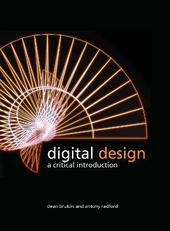
|
Digital Design: A Critical Introduction
Hardback
Main Details
| Title |
Digital Design: A Critical Introduction
|
| Authors and Contributors |
By (author) Dean Bruton
|
|
By (author) Antony Radford
|
| Physical Properties |
| Format:Hardback | | Pages:192 | | Dimensions(mm): Height 244,Width 189 |
|
| Category/Genre | Product design
Architectural structure and design
Computer-aided design (CAD) |
|---|
| ISBN/Barcode |
9781847888297
|
| Classifications | Dewey:745.40285 |
|---|
| Audience | | Professional & Vocational | |
|---|
| Illustrations |
31 colour & 189 bw illus
|
|
Publishing Details |
| Publisher |
Bloomsbury Publishing PLC
|
| Imprint |
Berg Publishers
|
| Publication Date |
1 October 2012 |
| Publication Country |
United Kingdom
|
Description
Digital Design: A Critical Introduction provides a much-needed new perspective on designing with digital media. Linking ideas from media theory, generative design and creativity with examples from nature, art, architecture, industrial design, websites, animation and games, it addresses some fundamental questions about creative design with digital media. Featuring original material based on the authors' own research, the book argues that the recognition and understanding of the interplay of the two apparently opposing concepts of rules and contingency supports original thinking, creativity and innovation. Going beyond existing texts on the subject, Digital Design is an accessible primer whose innovative approach transcends the analysis of individual subfields - such as animation, games and website design - yet offers practical help within all of them.
Author Biography
Dean Bruton is an artist leading the Digital Arts Program at the School of Arts and Social Sciences, Southern Cross University, Australia. He is author of Recollections: The Contemporary Art Society of South Australia 1943-86. Antony Radford is an urban designer and Emeritus Professor of Architecture at the University of Adelaide, Australia. He is co-author of CADD Made Easy, Knowledge-Based Design Systems, Understanding Sustainable Architecture, and Design by Optimization in Architecture, Building and Construction.
ReviewsEmphasising a maker's perspective on digital design - the nodes, networks, and the capacity for participation and evolution that digital media affords us - and maintaining a consistent conceptual position, this book makes the case for a generic approach to digital design. * Karen Cham, Kingston University, UK * As an artist myself I found the book very stimulating. The authors draw interesting connections between multiple topics. * Greg Johnson, Savannah College of Art and Design, USA *
|